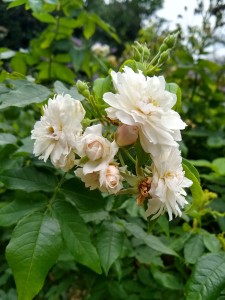 Not long ago I saw an absolutely arresting flower arrangement. It was composed of white roses, with a few blue delphiniums added for contrast. “White roses,” I thought, “Why doesn’t my garden have more white roses?”
Not long ago I saw an absolutely arresting flower arrangement. It was composed of white roses, with a few blue delphiniums added for contrast. “White roses,” I thought, “Why doesn’t my garden have more white roses?”
I am not sure what the answer is to that question. I do have three white-flowered bushes, but overall, my rose choices have tended to the yellow-pink-peach range. Some of the pale ones fade to white, but that is not the same. The blooms in the arresting arrangement reminded me how refreshing white roses can be.
‘Sally Holmes’, which thrives in my garden, is a hybrid musk introduced in 1976. ‘Sally’ is a large shrub that can top out at 12 feet, but can be kept shorter. I have also seen it used as a climber, trained very effectively up the side of a barn wall. The flowers are single, with five petals apiece, surrounding centers of golden stamens. Starting out as pink-tinged buds, the blooms are borne in clusters. By the time the buds open, the pink has disappeared, leaving only big, clear white petals. ‘Sally’ is tough and hardy, but also lasts extremely well in cut arrangements.
One of my other white roses is an older variety whose name has been lost. The small, pompom-like flowers appear in tight, showy clusters on flexible stems. Also pinkish in bud, the little blooms open white and are highly fragrant. Both the nameless rose and ‘Sally Holmes’ are among the last to close up shop in the fall.
Topping my list of potential white rose acquisitions is ‘Jacqueline du Pre’, another large shrub named after an English cello prodigy who died at the age of 42 in 1987. Like ‘Sally Holmes’, ‘Jacqueline du Pre’ boasts large single flowers. The white petals are scalloped at the edges and surround a cluster of very distinctive red stamens. ‘Jacqueline’s fragrance is strong, variously described as lemony, or musky or both. It is compelling, no matter what.
For flashy hybrid tea-type blooms, I would choose an old hybrid perpetual rose, ‘Frau Karl Druschki’, sometimes known in this country as ‘White American Beauty’. Each bloom has over 30 petals, cupped in classic form. A well grown ‘Druschki’ may bear individual flowers that are over five inches across. The only fly in the ointment–little or no scent. Still, the great twentieth century rosarian, Graham Stuart Thomas, called it “an indispensable white rose.”
My rose-loving father grew ‘John F. Kennedy’, a classic hybrid tea named after the fallen president. The shrub has been a favorite white rose since its 1965 introduction, and is all-American, bred in the United States by Jackson and Perkins. Its blooms are as big and many-petaled as those of ‘Frau Karl Druschki’, but also have a moderate fragrance. The long stems, elegant configuration and affinity for cut flower arrangements have kept the rose in commerce and in gardens.
‘Madam Hardy’ is another old rose, bred in France and introduced in 1835. It is a centifolia or damask rose, with a plethora of white petals surrounding a small green “eye”. Like many classic varieties, ‘Madam Hardy’ is flexible—literally and figuratively—and can be used as a shrub or trained up a pillar, reaching nearly seven feet in height. Like other damask roses, it has a strong, old rose fragrance. Its only liability, if it can be called that, is that it only blooms once a season. Still, gardeners all over the world continue to believe that this nearly two hundred year-old rose is eminently worth growing in modern landscapes.
For a shrub with the look and fragrance of an old rose on a compact shrub, check out ‘Winchester Cathedral’, a white-flowered offering from David Austin. It offers large, many-petaled blooms with classic rose fragrance on shrubs that top out at four feet tall and wide. Unlike ‘Madam Hardy’, ‘Winchester Cathedral’ blooms repeatedly throughout the growing season.
For something really tough, try ‘Blanc Double de Coubert’, a fragrant French hybrid rugosa rose. With the characteristically wrinkled rugosa foliage, ‘Coubert’ features a fully double array of relaxed white petals surrounding golden stamens. The fragrance is spicy and reminiscent of cloves, at least to some noses. It is a repeat bloomer and once established will stand up to just about anything the climate and/or the gardener can dish out. You will not want to corral the stems into a vase however, because they are heavily armed with prickles. ‘Coubert’ also produces the most beautiful large hips in the fall, giving it multiple seasons of interest.
If you are in need of a large flowered white climber, ‘City of York’ may be your ticket. With the ability to grow to 20 feet, if left to its own devices, ‘City of York’ needs a support structure, whether an obliging wall or arch. It will reward training efforts with big, white, mid-spring flowers, each with a large central boss of golden stamens. The blooms are semi-double, with about sixteen petals apiece, and are borne in clusters. I grow ‘City of York’, and have found it to be highly disease resistant. The shrub also occasionally surprises me with a few flowers after its initial flush of bloom.
You can sometimes find a few of the roses listed above at large local garden centers. For an impressive range of old and new white roses, try Rogue Valley Roses, Rogue Valley Roses
2368 Terri Dr, Medford, OR 97504; (541) 535-1307; www.roguevalleyroses.com.
